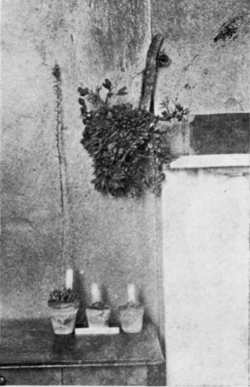countries, even when protected against the winter, literally takes the larger part of a century for its development. In the popular mind the idea of a century plant also includes the enormous species grown for pulque on the elevated plains to  Fig. 4. Giants and Pygmies. the south of the City of Mexico, and even larger plants of the same type, each of them reaching the weight of a ton or more, and sometimes producing a flower stalk nearly as thick as a man's body. In this sense, then, the name century plant becomes nearly equivalent to the Haitian name maguey, as now applied in Mexico, where the Spaniards introduced it in place of the Aztec name for these plants—metl. My use of the word, then, is rather as an equivalent of the botanist's generic name. Agave, than of this particular designation of a part of its species.
Fig. 4. Giants and Pygmies. the south of the City of Mexico, and even larger plants of the same type, each of them reaching the weight of a ton or more, and sometimes producing a flower stalk nearly as thick as a man's body. In this sense, then, the name century plant becomes nearly equivalent to the Haitian name maguey, as now applied in Mexico, where the Spaniards introduced it in place of the Aztec name for these plants—metl. My use of the word, then, is rather as an equivalent of the botanist's generic name. Agave, than of this particular designation of a part of its species.
A comparative notion of the size of these giants of the genus and its pygmies, with which I am here concerned, is afforded by a photograph of the latter, taken by the side of two of the fruiting branches of a mammoth West Indian species which I have hanging to a chimney breast in my study.  Fig. 5. Scarcely equals a Seed Vessel. The larger of these dwarfs is no larger than one's fist, and the smaller scarcely equals the seed-vessel of a great maguey.
Fig. 5. Scarcely equals a Seed Vessel. The larger of these dwarfs is no larger than one's fist, and the smaller scarcely equals the seed-vessel of a great maguey.
The larger of these species was first discovered by the international survey of the boundary between Arizona and Sonora, more than half a century ago, and although it is abundant on the ragged mountains of the boundary region, it has been collected very few times so far as yet known, since then: ten years ago near the one hundred and twenty-ninth boundary monument in the Pajarito Mountains by myself when I was looking up typical material of some of the species first made known through the International Boundary Survey; last year when
